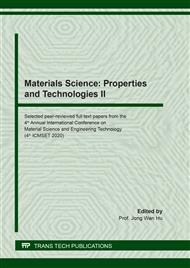[1]
M. Sarfraz, I. Shakir, Recent advances in layered double hydroxides as electrode materials for high-performance electrochemical energy storage devices, J. Energy Storage, 13 (2017) 103-122.
DOI: 10.1016/j.est.2017.06.011
Google Scholar
[2]
E. Goiklea, A. Balducci, K. Naoi, P. L. Taberna, M. Salanne, G. Yushin, Materials for supercapacitors: when Li-ion battery is not enough, Mater. Today, 21(4) (2018) 419-436.
DOI: 10.1016/j.mattod.2018.01.035
Google Scholar
[3]
T. C. Gonsalves, et al. Electrochemical Characteristics and Microstructures of Activated Carbon Powder Supercapacitors for Energy Storage, Mater. Sci. Forum, 930 (2018) 597-602.
DOI: 10.4028/www.scientific.net/msf.930.597
Google Scholar
[4]
M. L. Mao, et al. Metal-Organic Frameworks/Carboxyl Graphene Derived Porous Carbon as a Promising Supercapacitor Electrode Material, Key Eng. Mater. 727 (2017) 756-763.
DOI: 10.4028/www.scientific.net/kem.727.756
Google Scholar
[5]
A. M. Obeidat, A. G. Mohammad, M. Obaidat, Solid-state ultracapacitors with ionic liquid gel polymer electrolyte and polypyrrole electrodes for electrical energy storage, J. Energy Storage, 13 (2017) 123-128.
DOI: 10.1016/j.est.2017.07.010
Google Scholar
[6]
M. Ates, N. Uludag, T. Karazehir, F. Arıcan, Ultracapacitor Behavior of Poly(Carbazole-EDOT) Derivatives/multi-walled carbon nanotubes, characterizations and equivalent circuit model evaluations, J. Polym. Plastics Technol. Eng. 53(10) (2014) 1070-1081.
DOI: 10.1080/03602559.2014.886072
Google Scholar
[7]
L. S. Godse, V. N. Karkaria, M. J. Bhalerao, S. Khatua, P. B. Karandikar, Electrode-Electrolyte compatibility for superior performance of supercapacitor, Int. Conf. power Electronics Appl. Technol. (2019).
DOI: 10.1109/petpes47060.2019.9003864
Google Scholar
[8]
A. R. Mainar, E. Iruin, L. C. Colmenares, A. Kvasha, An overview of progress in electrolytes fo secondary zinc-air batteries and other storage systems based on zinc, J. Energy Storage, 15 (2018) 304-328.
DOI: 10.1016/j.est.2017.12.004
Google Scholar
[9]
K. M. Lee, M. J. Kim, K. S. Lee, Nylon 6, 6/polyaniline based sheath nanofibres for high performance supercapacitors, J. Eletrochimica Acta, 213 (2016) 124-131.
DOI: 10.1016/j.electacta.2016.07.104
Google Scholar
[10]
P. Mandake, P. B Karandikar, Effect of separator thickness variation for supercappacitor with polythylene separator material, IJSRSET, 2(2) (2016) 967-971.
Google Scholar
[11]
H. Upriti, A. Dixit, Shailendra, A. Paul, P. B. Karandikar, Optimization of electrode factors of stacked structured ultracapacitor, Energy Procedia, 54(6) (2014) 367-375.
DOI: 10.1016/j.egypro.2014.07.280
Google Scholar
[12]
P. B. Karandikar, D. B. Talange, U. Mhaskar, R. Bansal, Investigations for parameter improvement of manganese oxide based aqueous ultracapacitor, Mater. Manufact. Process. 11(1) (2012) 1164-1170.
DOI: 10.1080/10426914.2012.663139
Google Scholar
[13]
P. B.Karandikar, D. B.Talange, U. Mhaskar, R. Bansal, Validation of capacitance and ESR model of manganese oxide based aqueous ultracapacitor, Electric Power Components Syst. 10(1) (2012) 1105-1118.
DOI: 10.1080/15325008.2012.682247
Google Scholar
[14]
C. T. Pham, D. Månsson, Experimental validation of a general energy storage modeling approach (Part III), J. Energy Storage, 20 (2018) 542-550.
DOI: 10.1016/j.est.2018.09.023
Google Scholar
[15]
W. Luo, H. Xue, The Synthesis and Elechemical Performance of NiCo2O4 embedded Carbon nanofibers for high-performance supercapacitors, J. Fullerenes Nanotubes Carbon Nanostruct. 27(3) (2019) 189-197.
DOI: 10.1080/1536383x.2018.1538131
Google Scholar
[16]
K. Manikanda, T. Pradheep, S. Suresh, Application of Tauguchi and Response Surface Methodology (RSM) in Steel Turning Process toImprove Surface Roughness and Material Removal Rate, Mater. today:PROCEEDINGS, 5(11) (2018) 24622-24631.
DOI: 10.1016/j.matpr.2018.10.260
Google Scholar


